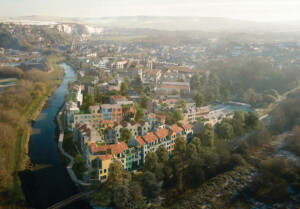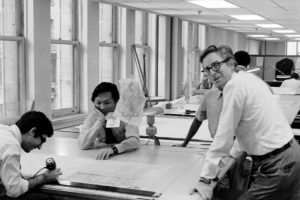This is an article from our special November timber issue.
Engineers specializing in cross-laminated timber (CLT) see its future less in boutique prototype towers, requiring case-by-case demonstrations for approval, than in a meat-and-potatoes mid-rise market. While, according to Colorado State University’s John van de Lindt, “some of those pioneering early CLT buildings are really almost like a partial R&D project in disguise,” he and colleagues predict that the field’s maturation depends on the incorporation of research-driven CLT standards into building codes.
“If you’re going to just do a two-story residential home, you have a perfect design code pathway to do it,” said Shiling Pei of the Colorado School of Mines, chief investigator on a National Science Foundation (NSF)-supported study of seismic design methods. “But if you want to go taller, especially [if] you want to go above 85 feet— that is currently IBC [International Building Code] for Type IV, heavy timber—then you have to do something else…a lot of testing to try to convince the local building-code officials.” He views CLT beyond about 20 stories skeptically, on economic grounds: “In my projects, I say it’s tall wood; it’s not high-rise wood.”
Pei cites the 2011 CLT Handbook by Canadian nonprofit FPInnovations as a pivotal document, republished in a 2013 U.S. edition with input from the American Wood Council (AWC), Forest Products Laboratory, WoodWorks, and APA: The Engineered Wood Association (formerly the American Plywood Association). In 2011, APA and the American National Standards Institute developed a performance-based standard, PRG 320, updating it in 2012 and 2017; it offers detailed specifications on CLT products’ composition, dimensions, shear strength, stiffness, and other properties. The AWC’s National Design Specifications for Wood Construction and the IBC include basic CLT sections in their 2015 editions.
Since seismic risks in Europe (Italy excepted) are milder, the transfer of CLT technology to Canada and the U.S., particularly for larger scales and open plans, requires standards addressing lateral forces. The next hurdle is for the American Society of Civil Engineers’ influential code book, ASCE 7: Minimum Design Loads for Buildings and Other Structures to address CLT, particularly its response-modification coefficient or R factor (not to be confused with R values for thermal resistance) in its seismic design provisions. “To make [CLT] economically competitive,” van de Lindt said, “it really needs to have these seismic performance coefficients (essentially an R factor) in the code, so that people don’t have to get special permission every time they want to use it,” incurring engineers’ reviewing costs. Results of van de Lindt’s R-factor studies are expected next year, and the code-revision cycle takes about five years; if a proposal based on the findings passes review by Building Seismic Safety Council committees and a public-comment period, it should enter the 2022 edition of ASCE 7, then IBC.
“With CLT, everything rotates like a rigid body under seismic stresses,” van de Lindt said. “Panels do not deform enough to dissipate energy and suck load right into them…. For a steel special moment frame that’s detailed for seismic, it can be an R of 8, [which has] a lot of ductility.” Yet adding concrete or steel lateral systems, as in Brock Commons (Acton Ostry Architects, Vancouver, page 12) and Carbon12 (PATH Architecture, Portland), respectively, requires multiple trades on-site and squanders CLT’s construction speed. Advanced “disruptive technologies” common in Japan (base or inter-story isolation using sliders, rockers, or damping devices) require special review. Very tall wood, 20 stories and above, he believes, calls for performance-based modeling rather than prescriptive tables and “will always require review, at least in our lifetime.”
Andre Barbosa of Oregon State University’s School of Civil and Construction Engineering and Tallwood Design Institute concurred, noting that CLT projects above about ten stories are often hybrids with concrete cores or steel for lateral resistance. “You get the best out of both materials. You have the CLT that’s lighter; [its] strength-to-weight ratio is very, very good. You get the concrete that allows you to go to longer spans, but also it creates that natural barrier for smoke and essentially for fire across floors.” Current methods of addressing timber’s susceptibility to moisture and insects are generally adequate, he says, adding that long-term deflection (creep) in CLT buildings tall enough for large loads needs further study.
Supported by the NSF’s Natural Hazards Engineering Research Infrastructure Tall Wood program, Pei and colleagues recently built a two-story prototype for testing on the world’s largest shake table at the University of California San Diego. Simulating 14 quakes of varying severity up through a “maximum credible earthquake,” a once in 2,500-years event, “the building essentially received no damage, and we don’t need to repair anything,” Pei reported, noting that CLT rocking walls actually outperformed their concrete and steel counterparts in resilience. His next studies will test a ten-story building under combined seismic stress and fire; the experiment has earned the inevitable nickname “shake and bake.”
Flammability is “a concern very often expressed, but an easy one to dismiss,” said Lech Muszynski, associate professor of wood science and engineering at Oregon State University’s College of Forestry. Studies support the counterintuitive idea that charring produces an insulating layer that actually slows pyrolysis, making it advance predictably and sparing enough wood to pass two-hour fire-resistance tests. “I’ve done some testing on unprotected CLT assemblies here in the states, large-scale floor and wall assemblies; there is a large library of similar tests being done in Europe in the past,” Muszynski reported, crediting Ario Ceccotti of the Istituto per la Valorizzazione del Legno e delle Specie Arboree (Trees and Timber Institute) for similar research in Italy and Japan. These tests have largely involved exposed CLT, though in practice the material is commonly encapsulated in gypsum board, adding another hour or so to its fire-resistance rating. Two commercial CLT manufacturers in the U.S., Muszynski noted, Oregon’s D.R. Johnson (which he advises) and Montana’s SmartLam, have their products fire-certified.
Steel components within joints, Muszynski added, are more vulnerable than the wood. He uses a photo from the 1906 San Francisco fire to illustrate “the difference between flammable and fire-safe”: A severely burnt wooden beam shows charring and exposed nails, indicating deep fire penetration, but remains rigid, while two heat-weakened steel beams flop across the wooden member, resembling soggy pasta. Adhesives also require attention: Some bonded timber products use melamine urea-formaldehyde resins, which harden under heat, but the more common adhesive is polyurethane, which softens if the char reaches bond lines. Moisture can be more hazardous when worksite protections are lacking: Muszynski recalls an Italian project where financial delays left a site idle for several months, exposing CLT to rain—and underscoring the importance of using contractors familiar with the material.










